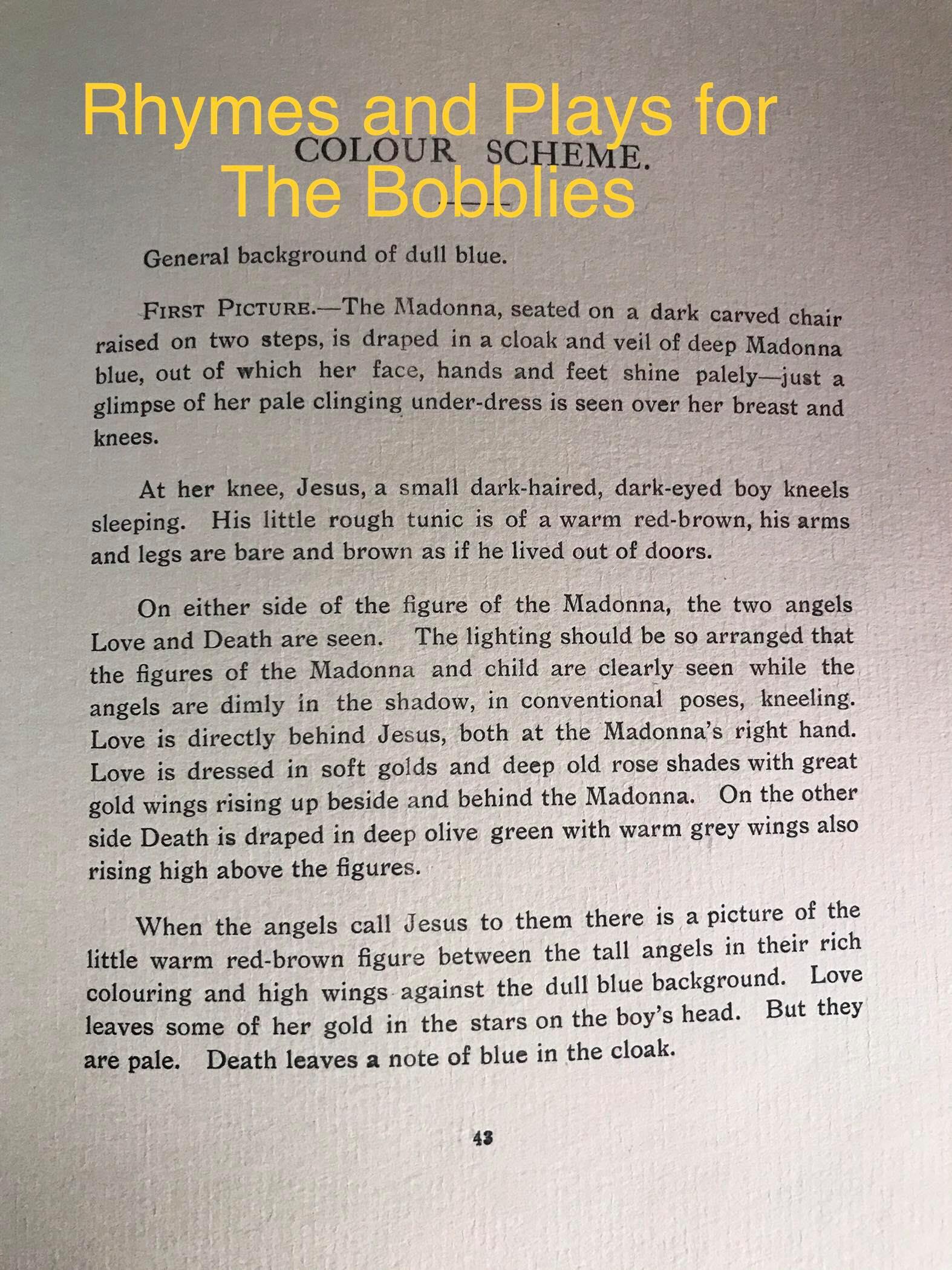BOBBLIES
Circa 1920, when Irene Mawer would have been in her late twenties, she wrote a book entitled ‘Rhymes and Plays for the Bobblies’. I have a copy of this book, though its provenance is unknown. The book is a soft back and the pages are made of very thick paper, almost like handmade paper. The edges of most of the pages are rough, as if the paper had been a larger sheet, folded in to, say quarters, and then instead of being cut to size with scissors or a blade, the paper was carefully torn against a flat edge such as a ruler. The book is a very strange affair and I can’t work out if it is a hand made ‘one off’ or a published work!
On the cover, the title is printed in red ink in the top left hand corner, with Irene Mawer’s name in the bottom right corner. There is a formal, printed notice on the inside of the front cover, stating “All rights reserved by the author. For production of all or part of this volume 10/6 for each performance. Application for permission to produce should be made to Irene Mawer, Lindsey Hall, The Mall, W.8.” 10/6 refers to the cost of gaining permission and is the ‘old’ money which was used before current decimal currency. It is pronounced “Ten and six” in its short form, or “Ten shillings and six pence” in full! The Lindsey Hall was in the Nottinghill Gate area of London and is where the Ginner-Mawer School of Dance and Drama was based from about 1920 until October 1924 (The Link, January 1925, p.25)
Previous to the Lindsey Hall, the school was based at a studio in South Kensington and moved premises due to the great increase in student numbers – including a large number of small children, known as Bobblies. At Lindsey Hall, staff members included Mrs Rushworth, Miss Simpson and Miss McBride (who I met in Leeds in the early 1980s).
A preface to this book reads “These Poems and Plays have been written for the children of the Bobbly School, by whom they have been performed at the Kingsway Theatre, London; Prince of Wales Theatre, London; Savoy Theatre, London; Memorial Theatre, Stratford-on-Avon.” ‘Stratford’ as it was known, was where the summer school was held each year, with a matinee always being performed at the Memorial theatre.
‘Rhymes and Plays for Bobblies’ was no doubt a big hit in its day – but it is certainly of its day, and I doubt very much that it would be used in a modern children’s class. The emphasis is very much on goblins, fairies, and pirates. The language is archaic and would inspire ridicule among today’s teachers and parents, in particular, the sexist themes. I was going to say that the names of some of the characters are ridiculous (eg, The Raggedy-Taggedy Man)- but then I remembered Tinky-Winky/Dipsy/Laa Laa/Po and also Sponge Bob Square Pants! Even so, I can’t quite get to grips with Mr Horny-Pan-Toes…
Many of the children in Miss Mawer’s poems feel sad and lost (“And then he left me all alone”; “The Little Lost Fairies”)and I wonder how much of an influence Peter Pan had on Irene? She was born in 1893 and Peter Pan was published in 1904, so she was perhaps a little old at the age of 11? The Book Trust suggest it has a reading age of 7+, though perhaps an 11 year old in 1904 would have been much less sophisticated that a child of that age today. There is also a large element of mystical, magical goings on in these children’s poems, eg, ‘the shadows in the garden seem full of little men’; ‘shadowy folk’;
There are also several references to mothers and motherless children or other motherless creatures: “It’s because they’ve got no mothers (these and all the others out there in the wood)”; “I’ve a mother and she loves me too”; “Lady Mother”; ‘Motherest of all”.
At the end of the book, in a play about Jesus as a child, Jesus says “I’m so tired with thinking. Why are thoughts so Big? They hurt me some-times.” What on earth could that be about? Does this say anything about Irene’s childhood? Or was it something that she was seeing in the children around her, the children who had been born during, or slightly before, World War One? The same short play also has two Angels: Love, and Death… not quite on the same level as Tinky Winky and friends…

